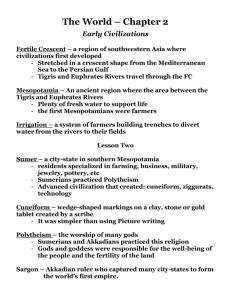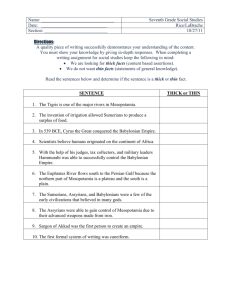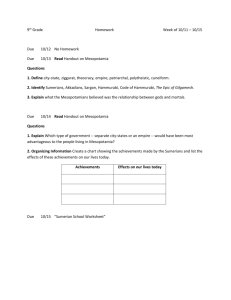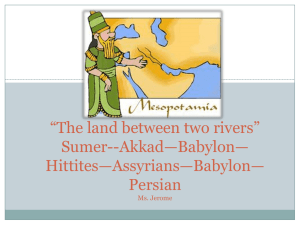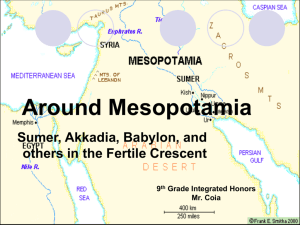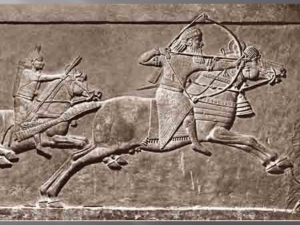Fertile Crescent
advertisement
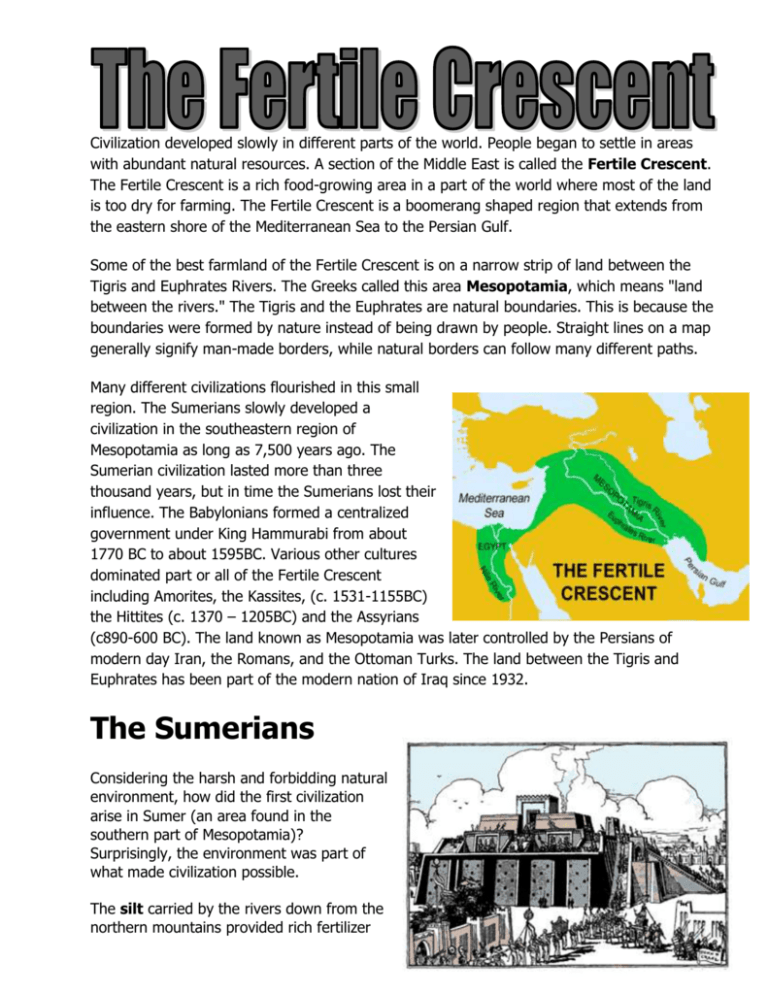
Civilization developed slowly in different parts of the world. People began to settle in areas with abundant natural resources. A section of the Middle East is called the Fertile Crescent. The Fertile Crescent is a rich food-growing area in a part of the world where most of the land is too dry for farming. The Fertile Crescent is a boomerang shaped region that extends from the eastern shore of the Mediterranean Sea to the Persian Gulf. Some of the best farmland of the Fertile Crescent is on a narrow strip of land between the Tigris and Euphrates Rivers. The Greeks called this area Mesopotamia, which means "land between the rivers." The Tigris and the Euphrates are natural boundaries. This is because the boundaries were formed by nature instead of being drawn by people. Straight lines on a map generally signify man-made borders, while natural borders can follow many different paths. Many different civilizations flourished in this small region. The Sumerians slowly developed a civilization in the southeastern region of Mesopotamia as long as 7,500 years ago. The Sumerian civilization lasted more than three thousand years, but in time the Sumerians lost their influence. The Babylonians formed a centralized government under King Hammurabi from about 1770 BC to about 1595BC. Various other cultures dominated part or all of the Fertile Crescent including Amorites, the Kassites, (c. 1531-1155BC) the Hittites (c. 1370 – 1205BC) and the Assyrians (c890-600 BC). The land known as Mesopotamia was later controlled by the Persians of modern day Iran, the Romans, and the Ottoman Turks. The land between the Tigris and Euphrates has been part of the modern nation of Iraq since 1932. The Sumerians Considering the harsh and forbidding natural environment, how did the first civilization arise in Sumer (an area found in the southern part of Mesopotamia)? Surprisingly, the environment was part of what made civilization possible. The silt carried by the rivers down from the northern mountains provided rich fertilizer for growing crops when the rivers overflowed. The constant sunshine was also good for crops. But without water, they would have easily dried up and died. Through the leadership of priestkings, Sumerians organized farmers in each city-state to build extensive irrigation systems of canals and dams. Before long, the desert was blooming with a surplus of barley, dates, and other crops. They built better canals for irrigating crops and for transporting crops by boat to village centers. They improved their roads, over which their donkeys trod, some of their donkeys pulling wheeled carts. And the Sumerians grew in number, the increase in population the key element in creating what we call civilization – a word derived from an ancient word for city. This surplus of food allowed many people to pursue occupations other than farming, while still being able to meet their basic needs. These people worked at other occupations-such as the priesthood, pottery making, weaving, carpentry and smithing. There were also traders, and the Sumerians developed an extensive commerce by land and sea. They built seaworthy ships, and they imported from afar items made from the wood, stone, tin and copper not found nearby. At least twelve cities arose among the Sumerians. Among them were Ur, Uruk, Kish and Lagash – Ur, for example, becoming a city of about 24,000 people. In the center of each city was a temple known as ziggurat that housed the city's gods. Ziggurats were pyramid-like structures with stepped platforms and each had a large stairway or ramp. Priests were the only ones allowed to climb the stairs to reach the small shrine at the top. Sumerians believed that the ziggurat was the god’s way of descending to earth. The Babylonians The Sumerians and Akkadians living in Mesopotamia became weaker and were conquered by the Amorites, a Semitic tribe from Syria. (Semitic relates to the peoples who speak the Semitic languages, esp. Hebrew and Arabic.) One Akkadian town that developed in approximately 1900BCE was the small town of Babylon, located by the Euphrates River. Babylon grew in size and importance, and eventually its ruler, King Hammurabi, conquered all of Mesopotamia. The kingdom became known as Babylonia. The Babylonian culture was similar to the Sumerian culture, which had existed in Mesopotamia before the Babylonians arrived. In fact, many people refer to the Babylonians as just a later development of the Sumerian culture. This is why some historians credit Sumeria with some inventions, while other historians credit the same advances to the Babylonians. This confusion is easy to understand. While the two civilizations existed at different times, they had many things in common. The Babylonians adopted the religion, literature, inventions, and practices of the Sumerians. Scholars and priests spoke the Sumerian language, although most Babylonians did not. While Babylonia borrowed heavily from the Sumerian cultures, they did make on important contribution to the world. This contribution was a code of laws known as the Code of Hammurabi. Hammurabi was king of Babylonia from 1792 BCE to 1750 BCE. He was a powerful leader with strong armies. Under his leadership, Babylon expanded by conquering other kingdoms. Hammurabi was not only an excellent military leader, but he was also an efficient administrator. While most ancient leaders considered only the comfort and pleasures of themselves and other noblemen, Hammurabi was also concerned with the lives of all of the people in his kingdom. He wanted everyone in his kingdom to have enough food, adequate housing, and to be treated fairly. In order to make sure that everyone was treated fairly, he had his scribes draw up a code of laws that are known as the Code of Hammurabi. The laws in the code were not completely original. They were taken, for the most part, from the written laws developed by the Sumerians. Hammurabi’s code was a little different from the laws devised by the Sumerians, however. Hammurabi’s code added the element of revenge. In Sumeria, most who committed a crime were fined. The Code of Hammurabi did not impose a fine on criminals, but substituted the ancient punishment of “an eye for an eye, and a tooth for a tooth.” In other words, if someone did something bad to a person, in many cases, the court would do the same thing to the wrongdoer. Law was not the only interest of the Babylonians. They studied astronomy and also believed in astrology. Astronomy is the study of the universe, including the movement of the stars and planets. Astrology is the belief that the position and movements of the planets and stars can affect or predict life on Earth. While we separate these two areas today, the Babylonians did not. The study of astronomy by the Babylonians was very advance for its time. They not only watched the stars and heavens, but kept records of events, such as when an eclipse occurred. They were able to measure time by studying the movements of the celestial bodies. The priests used their knowledge of planets and the stars as part of their religion. The priests claimed that by studying the celestial bodies, they could tell the future. They were constantly looking at the skies, making horoscopes and predictions based on what they saw. A horoscope is a prediction of a person’s future based on a diagram of the planets and stars at given moment, such as birth. About 1,000 years after the death of Hammurabi, another king came to power. His name was Nebuchadnezzar II. By his time, Babylon was part of the Chaldean Empire, which came to power after the Assyrian Empire was destroyed. Nebuchadnezzar ruled Babylon from 605 BCE to 562 BCE, and under his leadership, Babylon grew great. At this time, Babylon had two structures which were so impressive they were known throughout the civilized world. The first was the beautifully decorated wall surrounding Babylon. On top of the wall were towers for guards who could watch for approaching enemies. This wall was wide enough for a four horse chariot to be driven on it. While the wall had several gates through which travelers could enter and leave the city, the most impressive was the Gate of Ishtar. Ishtar was goddess, and the gate name in her honor was made of colorful glazed enamel bricks with pictures of animals. The gate was so beautiful that at one time it was considered one of the Seven Wonders of the Ancient World. It was later replaced by the Lighthouse at Alexandria. The second structure Nebuchadnezzar built that gained worldwide fame was the Hanging Gardens of Babylon. The Hanging Gardens are still considered one of the Seven Wonders of the Ancient World. Nebuchadnezzar was succeeded by his son in 562 BCE who was assassinated three years later. Within a few years, Babylon was invaded by the Persians, and Babylon became part of the Persian Empire. The Assyrians Assyria was a civilization in Mesopotamia on the upper Tigris River. The civilization lasted many centuries, but was most prominent between 1600 BCE and 612 BCE. Assyria had several advantages over Babylonia. Assyrians could farm without elaborate irrigation that was needed in Babylonia. The land not only received water from the Tigris River and its tributaries, but it also received a moderate amount of rainfall annually. Also Assyria had rocks and stones that could be used for building. Assyria had two disadvantages, however, compared to Babylonia. The Assyrian land was harder to cultivate, and they were often attacked by barbarians who raided their villages. Assyrians were a Semitic-speaking people who arrived in Mesopotamia about 2000 BCE. Assyria was named after its original capital, Ashur. Assyrians developed a thriving trade in Anatolia (Asia Minor or present day Turkey). Eventually the Hittites drove the Assyrians out of Anatolia, and when the Babylonian Kingdom became stronger under the leadership of King Hammurabi, Assyrian power in Mesopotamia grew weaker. By 1550 BCE Assyria became part of the Mitanni Kingdom. The notable achievement of the Mitanni Kingdom was that it introduced trained horses and chariots into this part of the world. Gradually, Assyrian power grew and by 1100 BCE, it was strong enough to begin expanding. Assyria’s method of expansion was very different from those of other civilizations. The Assyrians developed a standing army, which was composed of solders that chose the army as their career. When the soldiers were not fighting, they were still in the army training. This was a revolutionary idea during this period. Other countries fought their wars with citizensoldiers. Citizen-soldiers fight in a war, but when it is over, they would return home and resume their lives working at their former trade or craft. The Assyrian soldiers were fierce and cruel warriors. They had weapons made from iron rather than from copper or bronze. They also used the battering ram. They not only had foot soldiers, but they also had archers, chariots, and cavalry. Whenever they would capture enemies, they would either murder them or make them slaves. Captured cities were plundered and looted. Once a city was conquered by the Assyrians, the citizens were required to pay taxes and tribute to the Assyrians. The Assyrians built forts close to these cities, and a governor was appointed to administer each of these forts. The governor reported directly to the king by sending reports by messengers on horseback – the first mail delivery service. Nineveh became the capital city of the Assyrian Empire and city of learning. It had a library that housed thousands of clay tablets with writings from Sumer and Babylon. However, the success of the Assyrians was also their undoing. Because their kingdom was so large, it was impossible to maintain. There were too few soldiers, so mercenaries were hired to serve in the army. A mercenary is a foreign soldier hired by another country to fight in its army. Eventually the Assyrians were vanquished by the Medes, Chaldeans, and the Babylonians. The capital city of Nineveh was razed. The Persians The Persian Empire was located east of the Fertile Crescent on the east side of the Persian Gulf. It was the largest empire the world had ever known. Persia occupied land that is presently Iran and Afghanistan. Persians were not Semitic as many of the early civilizations in that part of the world had been. They were Indo-European and called themselves Aryans. The name Iran is based on the name Aryan. The Persians and the Medes came to this area in about 1300 BCE. The Medes were warriors who raided cities and caravans. In 550 BCE, Cyrus the Great, a Persian province ruler, led an army to defeat the Medes. Cyrus united the Medes and the Persians into a strong army to expand his kingdom. Cyrus and his army were very successful. In only 15 years, his army or archers and cavalrymen conquered almost all of the ancient world—this included Asia Minor (Turkey), the Fertile Crescent, the Indus Valley (India), and Egypt. The Persians treated those who they defeated fairly and kindly. In fact, there is some evidence that when the Babylonians were defeated by the Persians, many Babylonians welcomed the Persians because they were unhappy with their own king. Cyrus freed the Jewish captives and led them back to Jerusalem. The Persians allowed the kingdoms they defeated to maintain their own cultures rather than impose the Persian culture on them. Conquered people did, however, have to pay tribute to Persia. Cyrus was killed in battle in 530 BCE The Persian Empire gained further prominence under the leadership of Darius I, who ruled form 522 BCE to 486 BCE. The kingdom thrived. One of the qualities that made Darius a great leader was that he was a very good administrator and organizer. Since the Persian Empire was so large, the challenge was to maintain the lands it had acquired and to govern them efficiently. Darius divided this enormous empire into 20 provinces called satrapies. Each of these satrapies was managed by a governor called a satrap. Other leaders, such as judges and tax collectors, were Persians appointed by the emperor. The emperor also had an inspector who would visit the satrapies unannounced to make sure the officials were doing their jobs well and being loyal to the emperor. The Persians connected their empire with wellpaved roads, which encouraged international trade. One contribution of the Persians was the religion called Zoroastrianism. Zoroaster was a Persian prophet who had seven visions. These visions served as the basis for the religion called Zoroastrianism. Zoroastrianism became the official religion of the Persian Empire and flourished for many years. It is still practiced in some places today. The Avesta, the Persian Bible, based on the views of Zoroaster, teaches that there is one supreme god who made the world, sun, moon, and stars. Everything that is good in the world was created by this powerful god. His name is Ahura Mazda. He was the god of life. Another god, Ahriman, created everything that was evil and bad. He was the god of death. Persia fought several wars with the Greeks. The Persian Empire, which is sometimes called the Achaemenid Empire, lasted until 330 BCE when it was conquered by Alexander the Great.

